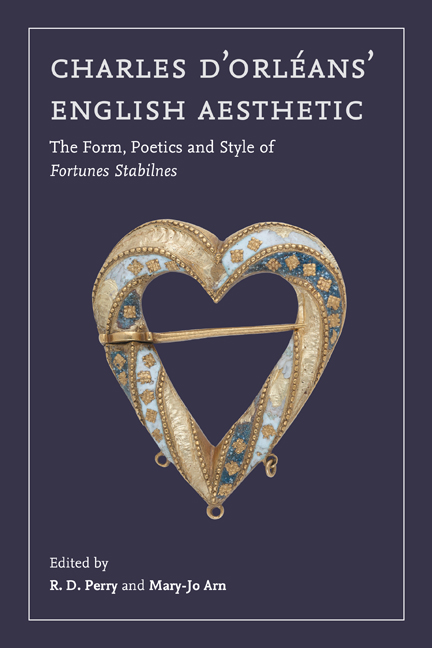Book contents
- Frontmatter
- Dedication
- Contents
- List of Illustrations
- List of Contributors
- Acknowledgements
- Abbreviations
- Introduction
- 1 The Two Dreams of Charles d’Orléans and the Structure of His English Book
- 2 Charles d’Orléans’ Cross-Channel Poetics: The Choice of Ballade Form in Fortunes Stabilnes
- 3 The English Roundel, Charles’s Jubilee, and Mimetic Form
- 4 A Grieving Lover: The Work of Mourning in Charles’s First Ballade Sequence
- 5 Charles d’Orléans’ English Metrical Phonology
- 6 The English Poetry of a Frenchman: Stress and Idiomaticity in Charles d’Orléans
- 7 Verb Use in Charles d’Orléans’ English
- 8 Charles d’Orléans and His Finding of English
- 9 Aureation as Agon: Charles d'Orléans versus John Lydgate
- 10 Charles d’Orléans, Harley 682, and the London Book-Trade
- 11 The Form of the Whole
- Select Publications, 2007–2020
- Index
8 - Charles d’Orléans and His Finding of English
Published online by Cambridge University Press: 14 October 2020
- Frontmatter
- Dedication
- Contents
- List of Illustrations
- List of Contributors
- Acknowledgements
- Abbreviations
- Introduction
- 1 The Two Dreams of Charles d’Orléans and the Structure of His English Book
- 2 Charles d’Orléans’ Cross-Channel Poetics: The Choice of Ballade Form in Fortunes Stabilnes
- 3 The English Roundel, Charles’s Jubilee, and Mimetic Form
- 4 A Grieving Lover: The Work of Mourning in Charles’s First Ballade Sequence
- 5 Charles d’Orléans’ English Metrical Phonology
- 6 The English Poetry of a Frenchman: Stress and Idiomaticity in Charles d’Orléans
- 7 Verb Use in Charles d’Orléans’ English
- 8 Charles d’Orléans and His Finding of English
- 9 Aureation as Agon: Charles d'Orléans versus John Lydgate
- 10 Charles d’Orléans, Harley 682, and the London Book-Trade
- 11 The Form of the Whole
- Select Publications, 2007–2020
- Index
Summary
Charles d’Orléans used English at a time when the language was becoming elaborated, that is, beginning to be used across a range of linguistic registers. The object of this chapter is to ‘place’ Charles in relation to his contemporaries in terms of language, with a view to identifying what he learned from his fellows and where he was fresh and innovative. In doing so the overall issue to be addressed will be: how did Charles deploy the linguistic resources available to him? Or, in other words, what kinds of invention (in the classical and medieval sense of ‘finding’) did Charles practise? Such questions lead us to a robust definition and understanding of Charles's style in relation to that of his contemporaries, and allow us moreover to assess the nature of his stylistic achievement within the culture in which he wrote, and in which his work was potentially received.
The English Voice of Charles d’Orléans
Mary-Jo Arn has urged us to resist ‘the attempt to read a detailed biography out of [the] poetry’ of Charles d’Orléans, and any reader of the English poems of London, British Library, MS Harley 682 will quickly realise that the poet has taken a delicately conventional approach to the love relationship. Although there is no reason to doubt that Charles – by all accounts ‘a very sociable, playful man’ – harnessed his own experience for his self-fashioning as a captive lover, the phraseology he deploys in his verses would have had a more generalised significance for his English- speaking contemporaries, allowing for broader, refined reflexions on amour courtois by a doubtless sympathetic audience of like-minded readers or listeners. In doing so, Charles clearly drew on the increasingly elaborated linguistic registers that fifteenth-century English supplied him with. But, as I will argue, he also found his own distinctive English ‘voice’, a voice that we can – albeit in many aspects only through the lens of a scribal intermediary – at least in part reconstruct.
The English Lexicon of Charles d’Orléans
Charles wrote, of course, at a time of considerable experimentation in the writing of English verse. In the previous generation of writers Geoffrey Chaucer had led the way in the development of the five-stress iambic line, whose extra foot allowed more easily for enjambment, but subsequent changes in English grammar, most notably inflexional loss, meant that later writers had to find new ways to deploy handy unstressed syllables.
- Type
- Chapter
- Information
- Charles d’Orléans' English AestheticThe Form, Poetics, and Style of Fortunes Stabilnes, pp. 189 - 220Publisher: Boydell & BrewerPrint publication year: 2020
- 1
- Cited by



